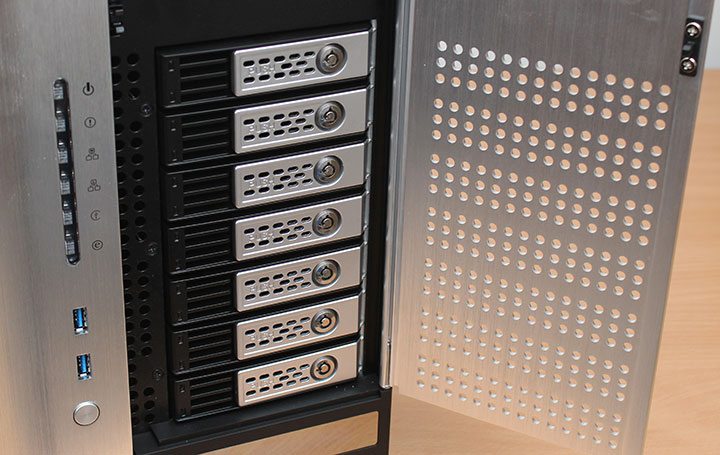Thecus N7510 7-Bay NAS Review
Chris Hadley / 12 years ago
Looking at the unit as a whole, first impressions are that it’s very stylish with the blushed aluminium front and corner panel, whilst the rest of the chassis is finished in a matt black coat of paint.

Below the drive bays is the OLED display which when looked at from an angle has a reflective appearance, meaning that the screen has a low viewing angle however this is compensated by the clear bright display.

Down the left hand side in the brushed corner panel is an array of status and activity LEDs for LAN, system, USB, updates etc. Like the display these are nice and bright, but not so bright that they glare too much.

Further down the left hand side are two USB3.0 ports which is becoming a standard feature on Thecus products, and a slightly raised power button.


Like many other Theucs products the N7510 includes lockable drive trays and to the left hand side are two strips through which the individual LED status lights shine through.

Working our way down the rear of the system, we find three 3.5mm audio ports for mic, line-in and line-out, eSATA, four USB 2.0, dual Gigabit LAN, HDMI and VGA outputs. To the left of the I/O are two 80mm fans to keep the system cool and quiet.

At the top of the system is an expansion slot, but this is not a PCI-e x8 slot as we can see further down so the choice of add-in cards is a little limited.

At the bottom of the system we find the single plug power supply, which does appear to be removable, although the system will need to be opened up to unplug as it is not hot-swappable.

Breaking the NAS down and looking at the motherboard a little closer, the N7510 is powered by an Intel Atom dual-core processor which is more than capable for SOHO applications, and to the left we can see that there is space for extra memory in the system which would be able to boost RAID performance especially on the parity side of things. We can also see in the middle the SATA DOM module which holds the units OS rather than using a traditional drive. To the right of this is the previously mentioned expansion slot which isn’t of a traditional PCIe design meaning that the choice of expansion cards is limited and sadly we won’t see 10GBe available on this unit.




















